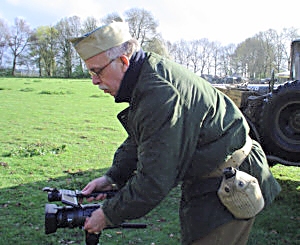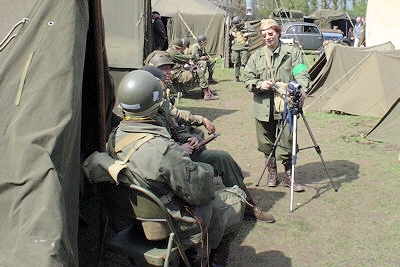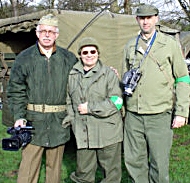
|
The world of non-commercial film and A-V |
Events Diary | Search | ||
| The Film and Video Institute | | ||||
The making of Living History
 Living
History was awarded 4-stars at BIAFF 2008
Living
History was awarded 4-stars at BIAFF 2008
First of all I am very honoured to get a Four Stars Award for my movie - thanks a lot!
My "graphic career" started when I was 12 and bought my first photo-reflex camera an Asiha-Pentax and began developing the photos myself. Up to 2001 I did not have a video-camera and bought my first computer in 2001. I bought my first film camera (Sony PC100) in 2001 and became a member of the local film club SGD in Dordrecht in 2003 in order to learn about editing movies. I learned to work with Premiere 6.5 (via Adobe's Classroom in a Book) and started making my first movies in 2004.
Since I worked in Rotterdam for a warehousing-company as manager of the tea-division, I had good contacts with tea-merchants and interviewed one of my clients about tea-trading, blending, plucking, tasting, etc. So I made my first movie called De Stille Kracht (the Silent Power). It won first prize in the annual-competition of my film club and got a nomination for the District competition which resulted in a nomination for the National NOVA competition, where I won a bronze medal.1
So my start was promising.
In 2003 I bought a second camera, a Sony TRV-950 and in 2006 a Sony HDV-FX1 including a Sennheiser wireless microphone system. In 2005 and 2006 my movies again went to the District competition level (2006 with Living History).
[Ed: Some brief scenes in Living History are taken from a professional scope movie and we asked Jos why he had not made them conform to the same shape as the rest of the images.]
I taught myself editing movies, but don't ask me anything about computers, so changing letterbox into 4x3 was beyond my competence. Nevertheless I don't mind as I just want my viewers to understand that these scenes are copied from movies, so the format change is no problem to me.
 The
hobby of a guy who was working at the tea company, was historical re-enactment
and he asked me whether I was interested in making a film about a Liberation
Tour of 175 historic vehicles celebrating the end of WWII in the Netherlands.
I asked Ineke van Alten from my film club to make the movie together
with me and she helped me filming during the historical weekend. Also Emile
de Gruijter helped me one day with a third camera. Three historical Jeeps
were driving us around.
The
hobby of a guy who was working at the tea company, was historical re-enactment
and he asked me whether I was interested in making a film about a Liberation
Tour of 175 historic vehicles celebrating the end of WWII in the Netherlands.
I asked Ineke van Alten from my film club to make the movie together
with me and she helped me filming during the historical weekend. Also Emile
de Gruijter helped me one day with a third camera. Three historical Jeeps
were driving us around.
As I was filming most of the interviews alone, I recruited two of the re-enactment group to ask the questions. We interviewed in several places in Holland such as the region known as "Men's Island" in the Betuwe region, near Arnhem; and at the American Cemeteries in Margraten and in Colleville-sur-Mere in Normandy.
In the town of Nijmegen the movie was shown six times on the local television-net as they were stunned by the scenes of crossing the river Waal at Nijmegen which was a very important part of Operation Market Garden.2 The television company signed a contract with me, paying the rights for the music and the B/W movie scenes to Buma/Stemra. [The copyright licensing body in The Netherlands.]
The American embassy in the Hague was asking to get a copy and the American , French and UK people I met in Holland and France got a copy as well . The German boys got a copy too. Interviewing young Germans where a father was fighting with the German Paratroopers against the American Paratroopers was sensational. It's because of foreign interest I decided to dub the movie in English with English voice-over.
| I used my Sony HDV-FX1 + Manfrotto tripod 525MVB/head 503.
Emile de Gruijter filmed one day with my TRV-950, Ineke filmed with her own
Sony camera. All the interviews were done with my wireless Sennheiser microphone
system EW122.
It took me in total a year to complete Living History (Dutch and English version.) The translation into English was done by Jan and Iris Schoonen which was a great help. The editing was done by myself with Adobe Premiere 6.5. Now in 2008 I am working with Adobe Pro 2.0 and Photoshop CS3. So far as filming problems are concerned I can only say, if I am not satisfied with the result I do it again, till it is ok for me. And in editing I take my time. - Jos Dubbeldam |
 |
l - r
|
The Dutch version of the film (with many of the interviews actually in English)
is available on the internet at
www.webuitzendingen.nl/video/JDub/LH_jd01.htm.
It needs to be viewed in Internet Explorer or in Firefox with the IE tab
plug-in.
| 1 | In the Netherlands and some other countries films go to the national competition through a series of local and regional heats. This method is not used in Britain, partly because all three major amateur film festivals are international, |
| 2 | Operation Market Garden took place during 8 days in September 1944 when Allied airborne forces sought to secure strategic bridges over the main rivers of the Netherlands and Germany so that armoured troops could make a rapid advance. It was recounted in the professional movie A Bridge Too Far. |
Share your passions.

Share your stories.